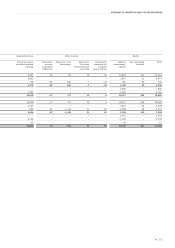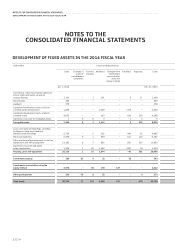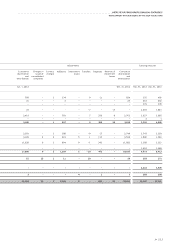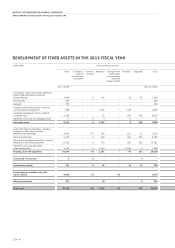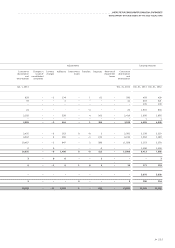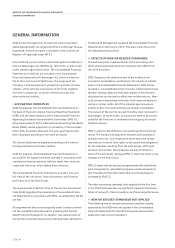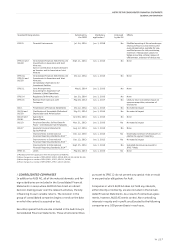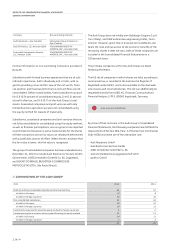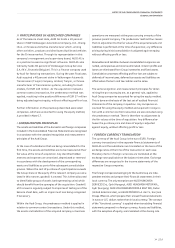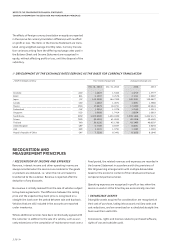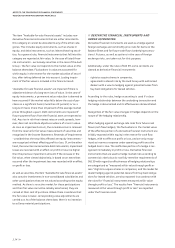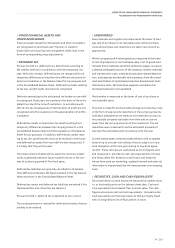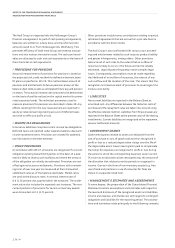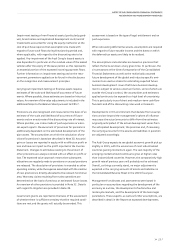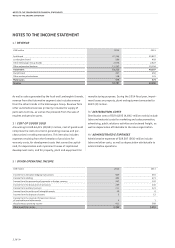Audi 2014 Annual Report Download - page 229
Download and view the complete annual report
Please find page 229 of the 2014 Audi annual report below. You can navigate through the pages in the report by either clicking on the pages listed below, or by using the keyword search tool below to find specific information within the annual report.
NOTES TO THE CONSOLIDATED FINANCIAL STATEMENTS
GENERAL INFORMATION
>>
229
//
PARTICIPATIONS IN ASSOCIATED COMPANIES
As of the balance sheet date, AUDI AG holds a 10 percent
share in FAW-Volkswagen Automotive Company, Ltd., Chang-
chun, a Chinese automotive manufacturer which, among
other activities, produces and distributes Audi brand vehicles
for the Chinese market. Through its representation in this
company’s management and supervisory board, AUDI AG is
in a position to exercise significant influence. AUDI AG also
indirectly holds 30 percent of Volkswagen Group Services
S.A./N.V., Brussels (Belgium). This is a finance company used
by Audi for factoring transactions. During the past fiscal year,
Audi acquired a 40 percent stake in Volkswagen Automatic
Transmission (Tianjin) Company Limited, Tianjiin, a Chinese
manufacturer of transmission systems, including for Audi
models, for EUR 145 million. As the acquisition involved a
common control transaction, the predecessor method was
applied, resulting in the positive difference of EUR 27 million
being adjusted against equity, without affecting profit or loss.
Further information on the previously described associated
companies, which are accounted for using the equity method,
is provided in Note 17.
/
CONSOLIDATION PRINCIPLES
The assets and liabilities of the domestic and foreign companies
included in the Consolidated Financial Statements are recognized
in accordance with the standard recognition and measurement
principles of the Audi Group.
In the case of subsidiaries that are being consolidated for the
first time, the assets and liabilities are to be measured at their
fair value at the time of acquisition. Any identified hidden
reserves and expenses are amortized, depreciated or reversed
in accordance with the development of the corresponding
assets and liabilities as part of the subsequent consolidation
process. Where the cost of purchase of a participation exceeds
the Group share in the equity of the relevant company as calcu-
lated in this manner, goodwill is created. This is then allocated
to identifiable groups of assets (cash-generating units) which
should benefit from the synergies of the acquisition. Goodwill
at this level is regularly subject to impairment testing as of the
balance sheet date, with an impairment loss being recognized
if necessary.
Within the Audi Group, the predecessor method is applied in
relation to common control transactions. Under this method,
the assets and liabilities of the acquired company or business
operations are measured at the gross carrying amounts of the
previous parent company. The predecessor method thus means
that no adjustment to the fair value of the acquired assets and
liabilities is performed at the time of acquisition; any difference
arising during initial consolidation is adjusted against equity,
without affecting profit or loss.
Receivables and liabilities between consolidated companies are
netted, and expenses and income eliminated. Interim profits and
losses are eliminated from Group inventories and fixed assets.
Consolidation processes affecting profit or loss are subject to
deferrals of income taxes; deferred tax assets and liabilities are
offset where the term and tax creditor are the same.
The same recognition and measurement principles for deter-
mining the pro rata equity are, as a general rule, applied to
Audi Group companies accounted for using the equity method.
This is done on the basis of the last set of audited financial
statements of the company in question. Any companies ac-
counted for using the equity method and acquired in conjunc-
tion with a common control transaction are also included using
the predecessor method. There is therefore no adjustment to
the fair values at the time of acquisition. Any difference be-
tween the purchase price and share of equity is adjusted
against equity, without affecting profit or loss.
/
FOREIGN CURRENCY TRANSLATION
The currency of the Audi Group is the euro (EUR). Foreign
currency transactions in the separate financial statements of
AUDI AG and the subsidiaries are translated on the basis of the
exchange rates at the time of the transaction in each case.
Monetary items in foreign currencies are translated at the
exchange rate applicable on the balance sheet date. Exchange
differences are recognized in the income statements of the
respective Group companies.
The foreign companies belonging to the Audi Group are inde-
pendent entities and prepare their financial statements in their
local currency. The only exceptions are AUDI HUNGARIA
SERVICES Zrt., GyƉr (Hungary), AUDI HUNGARIA MOTOR Kft.,
GyƉr (Hungary), AUDI VOLKSWAGEN MIDDLE EAST FZE, Dubai
(United Arab Emirates), and AUDI MÉXICO S.A. de C.V., San José
Chiapa (Mexico), which prepare their annual financial statements
in euros or U.S. dollars rather than in local currency. The concept
of the “functional currency” is applied when translating financial
statements prepared in a foreign currency. Assets and liabilities,
with the exception of equity, are translated at the closing rate.




